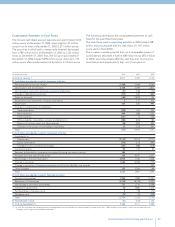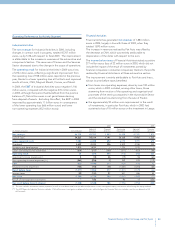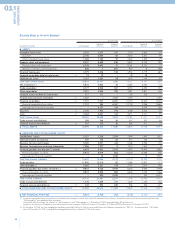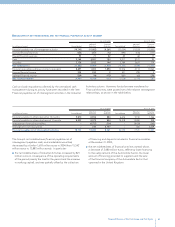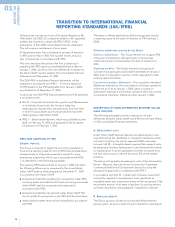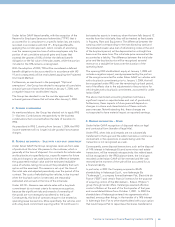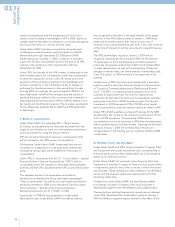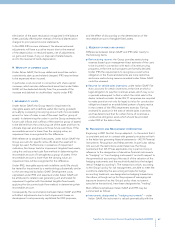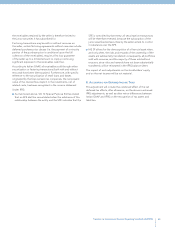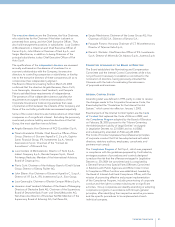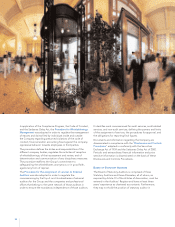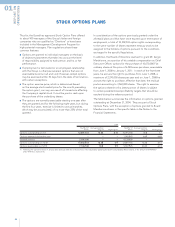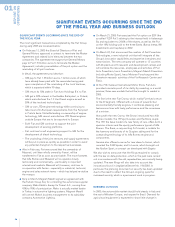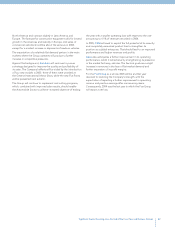Chrysler 2004 Annual Report Download - page 49
Download and view the complete annual report
Please find page 49 of the 2004 Chrysler annual report below. You can navigate through the pages in the report by either clicking on the pages listed below, or by using the keyword search tool below to find specific information within the annual report.
47
elimination of the asset revaluation recognized in the balance
sheet, partially offset by the reversal of the land depreciation
charged to prior period income statements.
In the 2004 IFRS income statement, the abovementioned
adjustments will have a positive impact due to the reversal
of the depreciation on revalued assets, net of adjustments
on gains and losses, if any, on disposal of related assets,
and to the reversal of lands depreciation.
H. WRITE-OFF OF DEFERRED COSTS
Under Italian GAAP, the Group defers and amortizes certain
costs (mainly start-up and related charges). IFRS require these
to be expensed when incurred.
In particular, costs incurred in connection with share capital
increases, which are also deferred and amortized under Italian
GAAP, will be deducted directly from the proceeds of the
increase and debited to stockholders’ equity under IFRS.
I. IMPAIRMENT OF ASSETS
Under Italian GAAP, the Group tests for impairment its
intangible assets with indefinite useful life (mainly goodwill)
annually by comparing its carrying amount with its recoverable
amount in term of value in use of the asset itself (or group of
assets). In determining the value in use the Group estimates the
future cash inflows and outflows of the asset (or group of assets)
to be derived from the continuing use of the asset and from its
ultimate disposal, and discounts those future cash flows. If the
recoverable amount is lower than the carrying value, an
impairment loss is recognized for the difference.
With reference to tangible fixed assets, under Italian GAAP the
Group accounts for specific write-offs when the asset will no
longer be used. Furthermore, in presence of impairment
indicators, the Group tests for impairment tangible fixed assets,
using the undiscounted cash flow method in determining the
recoverable amount of homogeneous group of assets. If the
recoverable amount is lower than the carrying value, an
impairment loss will be recognized for the difference.
Under IFRS, intangible assets with indefinite useful life should
be tested for impairment by a methodology substantially similar
to the one required by Italian GAAP. Development costs,
capitalized under IFRS and expensed under Italian GAAP, will
be attributed to related cash generating unit and tested for
impairment together with the related tangible fixed assets,
applying the discounted cash flow method in determining their
recoverable amount.
Consequently, the reconciliation between Italian GAAP and IFRS
will reflect adjustments due to both impairment losses on
development costs previously capitalized for IFRS purposes,
and the effect of discounting on the determination of the
recoverable amount of tangible fixed assets.
L. RESERVES FOR RISKS AND CHARGES
Differences between Italian GAAP and IFRS refer mainly to
the following items:
■Restructuring reserve:the Group provides restructuring
reserves based upon management best estimate of the costs
to be incurred in connection with each of its restructuring
programs at the time such programs are formally decided.
Under IFRS the requirements to recognize a constructive
obligation in the financial statements are more restrictive,
and some restructuring reserve recorded under Italian GAAP
could be reversed.
■Reserve for vehicle sales incentives:under Italian GAAP Fiat
Auto accounts for certain incentives at the time at which a
legal obligation to pay the incentives arises, which may occur
in periods subsequent to that in which the initial sale to the
dealer network is made. Under IAS 37 companies are required
to make provision not only for legal, but also for constructive
obligations based on an established pattern of past practice.
In the context of the IFRS restatement exercise, Fiat has
reviewed its practice in the area of vehicle sales incentives
and has determined that for certain forms of incentives a
constructive obligation exists which should be provided
under IFRS at the date of sale.
M. RECOGNITION AND MEASUREMENT OF DERIVATIVES
Beginning in 2001 the Fiat Group adopted – to the extent that it
is consistent and not in contrast with general principles set forth
in the Italian law governing financial statements – IAS 39 Financial
Instruments: Recognition and Measurement. In particular, taking
into account the restrictions under Italian law, the Group
maintained that IAS 39 was applicable only in part and only in
reference to the designation of derivative financial instruments
as “hedging” or “non-hedging instruments” and with respect to
the symmetrical accounting of the result of the valuation of the
hedging instruments and the result attributable to the hedged
items (“hedge accounting”). The transactions which, according
to the Group’s policy for risk management, are able to meet the
conditions stated by the accounting principle for hedge
accounting treatment, are designated as hedging transactions;
the others, although set up for the purpose of managing risk
exposure (inasmuch as the Group’s policy does not permit
speculative transactions), have been designated as “trading”.
Main differences between Italian GAAP and IFRS may be
summarized as follows:
■Instruments designated as “hedging instruments” – under
Italian GAAP, the instrument is valued symmetrically with the
Transition to International Financial Reporting Standards (IAS/IFRS)


